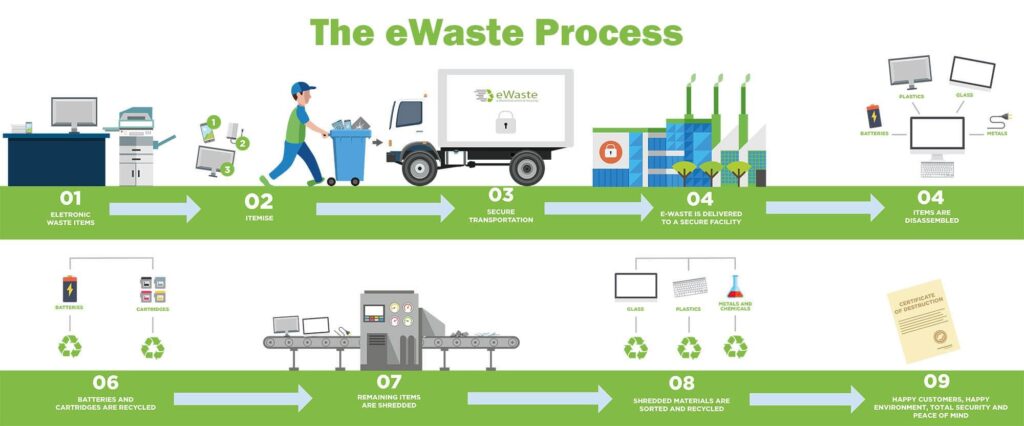In today’s fast-paced digital age, electronic devices have become an integral part of our lives. From smartphones to laptops and everything in between, the constant upgrade cycle means that old devices often end up discarded. However, improper disposal of electronic waste (e-waste) can have severe environmental consequences. So, what is the best way to recycle e-waste? Let’s delve into this pressing issue and discover sustainable solutions.
Best Way to Recycle E-Waste: Understanding E-Waste
Best Way to Recycle E-Waste: E-waste encompasses a broad range of electronic devices, including smartphones, computers, televisions, and more. These devices contain various materials, including metals, plastics, and hazardous substances like lead and mercury. Improper disposal can lead to pollution of air, soil, and water, posing significant risks to human health and the environment.
The Environmental Impact
Best Way to Recycle E-Waste: E-waste disposal presents several environmental challenges, including:
- Toxic Leachate: When e-waste ends up in landfills, hazardous chemicals can leach into the soil and groundwater, contaminating ecosystems.
- Air Pollution: Burning e-waste releases toxic fumes into the atmosphere, contributing to air pollution and respiratory ailments.
- Resource Depletion: Electronic devices contain valuable resources like gold, silver, and rare earth metals. Recycling e-waste helps recover these resources, reducing the need for raw material extraction.
Best Way to Recycle E-Waste
Proper e-waste recycling is crucial for minimizing environmental impact and conserving resources. Here are some effective strategies:
1. Collection and Sorting
Establish collection centers where individuals can drop off their old electronic devices. Ensure proper sorting based on device type and condition to facilitate efficient recycling processes.
2. Data Security Measures
Before recycling electronic devices, ensure that all personal data is securely erased to protect user privacy. Use data wiping software or physical destruction methods to prevent unauthorized access.
3. Reuse and Refurbishment
Promote the reuse and refurbishment of functional electronic devices. Organizations can refurbish old computers and smartphones, extending their lifespan and reducing the demand for new products.
4. Material Recovery
Utilize advanced recycling technologies to extract valuable materials from e-waste. These processes involve shredding, sorting, and refining to recover metals, plastics, and other recyclable components.
5. Manufacturer Responsibility
Encourage electronics manufacturers to take responsibility for the end-of-life disposal of their products. Implementing extended producer responsibility (EPR) programs ensures that manufacturers bear the cost of recycling and disposal.
6. Consumer Education
Educate consumers about the importance of responsible e-waste disposal. Provide information on recycling options, environmental impacts, and the benefits of recycling electronic devices.
Challenges and Opportunities
While e-waste recycling initiatives have made significant progress, several challenges remain. These include:
- Lack of Awareness: Many individuals are unaware of proper e-waste disposal methods and the environmental consequences of improper disposal.
- Regulatory Framework: Inconsistent regulations across regions pose challenges for effective e-waste management.
- Technological Advances: Rapid technological advancements result in shorter product lifecycles, leading to a surge in e-waste generation.
However, these challenges also present opportunities for innovation and collaboration. By leveraging technology, raising awareness, and implementing robust regulatory frameworks, we can address the e-waste problem and create a more sustainable future.
Frequently Asked Questions (FAQs)
- How can I recycle my old smartphone?
- Old smartphones can be recycled through manufacturer take-back programs, electronic recycling centers, or mobile carrier trade-in programs.
- Is it safe to recycle electronic devices with personal data?
- Yes, it’s safe to recycle electronic devices with personal data if you ensure proper data wiping or destruction before disposal.
- What happens to recycled e-waste?
- Recycled e-waste undergoes processes such as shredding, sorting, and refining to extract valuable materials for reuse in manufacturing.
- Can I recycle damaged electronic devices?
- Yes, damaged electronic devices can still be recycled. Advanced recycling technologies can recover valuable materials even from non-functional devices.
- Are there any regulations for e-waste recycling?
- Many countries have regulations governing e-waste recycling, including extended producer responsibility (EPR) laws and restrictions on hazardous materials.
- What are the benefits of recycling e-waste?
- Recycling e-waste conserves resources, reduces pollution, and mitigates the environmental and health risks associated with improper disposal.
In conclusion Best Way to Recycle E-Waste, responsible e-waste recycling is essential for mitigating environmental impact and conserving valuable resources. By adopting best practices, raising awareness, and fostering collaboration among stakeholders, we can pave the way for a sustainable e-waste management system. Together, let’s take proactive steps towards a cleaner, greener future.


